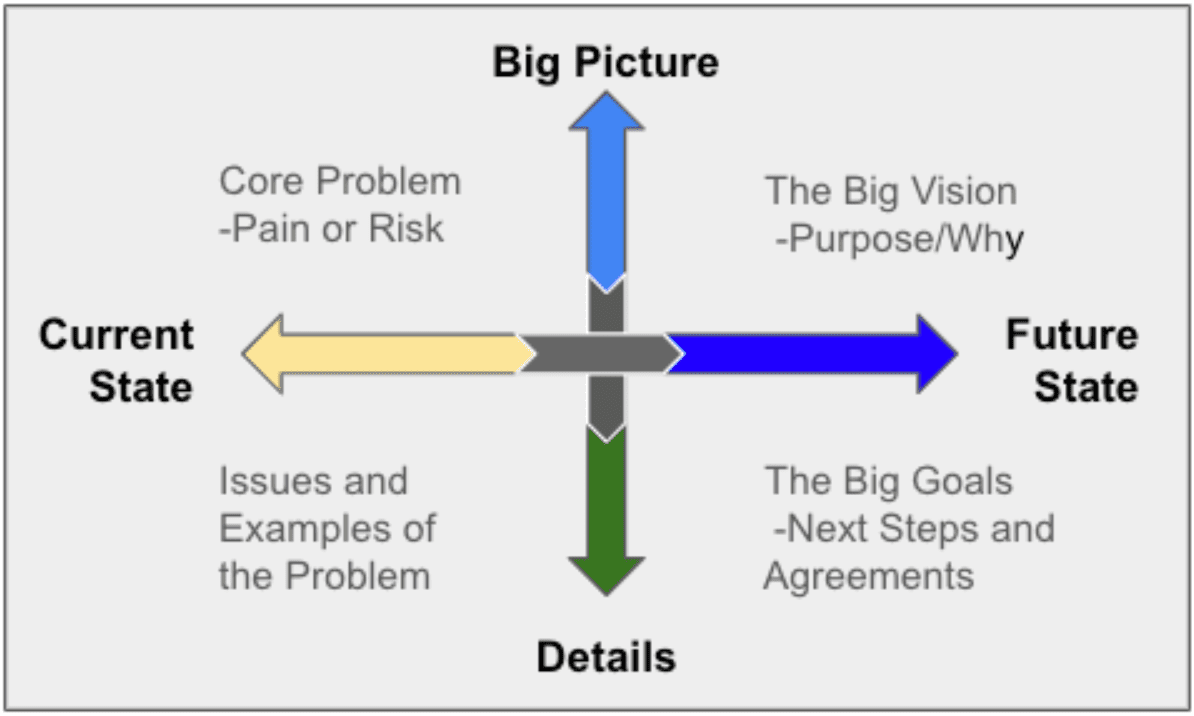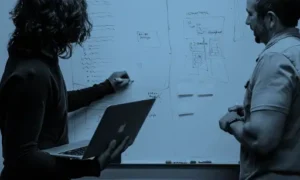Leaders who possess a comprehensive grasp of their team’s activities within their overall strategy demonstrate “strategic clarity.” These types of leaders are invaluable, as they ensure that their team’s efforts are purposeful, they break down information barriers, foster cross-functional collaboration and effectively communicate each activity’s contribution to achieving their objectives.
Businesses can unlock their full potential by linking every department, goal, person and task to a common vision. Though establishing strategic clarity may seem complex, it can be achieved intuitively with the proper framework.
Strategic clarity map: a definition
A strategic clarity map is a straightforward yet potent diagram that aids business leaders in defining their present and desired states. It also helps them in devising a roadmap for transitioning from the “current state” to the “future state.”
The strategic clarity map consists of two major components: the horizontal bar represents the transition from the current state (where you are now) to the future state (where you want to be next year). The vertical bar illustrates the alignment from the big picture of your business strategy to the specific details of boots-on-the-ground work.

Assessing your current to desired state
The present-to-future bar provides an opportunity to evaluate existing gaps and measure them against your desired state.
Several important questions to consider:
- How can I identify the challenges my team encounters, and what’s causing them? Challenges may include a lack of clarity regarding priorities or decision-making processes, conflicts in personalities, insufficient accountability, inadequate workload resources or an imbalanced distribution of work between IT and non-IT development projects.
- What are the major hurdles that hinder your team’s performance? Consider your operations carefully: where do inefficiencies originate? What changes or updates could increase the value of your time?
- What actions should you start taking? What modifications could you make in your leadership approach to enhance your team’s performance? Do you face conflicting priorities? Is it unclear why one task should take precedence over others?
- How can things improve next year? Envision what positive changes could occur. What should your team’s vision and goals look like? What adjustments are necessary to achieve these goals? What steps can you take now to initiate these changes?
Analyzing the status of your big picture-to-details
The present-to-future bar is divided; the crucial factor in bridging the gap between your current state and achieving your objectives is implementing the following.
Define your big picture by zooming out:
- What are your company’s mission, values and strategy? At the core of your organization lie your values and mission, which are put into action through strategy. Without a precise comprehension of your “why” and “how,” it is challenging to unify your teams, activities and processes.
Next, identify more specific details by zooming in:
- Are your tasks aligned with the overall strategy? Take a moment to position your team’s day-to-day activities within the big picture. Is everything cohesive?
- Is the strategy supported by your metrics? How do you measure success? Are these metrics in line with your big-picture goals?
- Is the strategy aligned with your team’s execution plan? At the team level, do tasks and activities contribute to achieving your big-picture objectives? Is each team member clear about their role in realizing company goals?
- Is the strategy aligned with your individual action plan? By zooming into the individual level, you can determine whether tasks and activities support the big picture. Do individuals have clarity on their significance in achieving your goals?
Unlocking the power of strategic clarity
You’ve identified the biggest hurdles hindering your business goals and clarified them along with your goals, values and current strategy alignment.
Although the strategic clarity map may raise more questions, it also provides a framework to answer them. This is a significant step towards achieving strategic clarity, where everyone knows how their tasks contribute to the big-picture mission.
This positions the year as a pivotal one, and the dividends of newfound strategic clarity will be visible in the next few months.
John Volturo is a partner at Evolution, a coaching, consulting, and investment firm, an International Coaching Federation (ICF) credentialed PCC Executive Coach, 2021 President of ICF in Los Angeles (ICF-LA, PCC), and former Chief Marketing Officer.


































